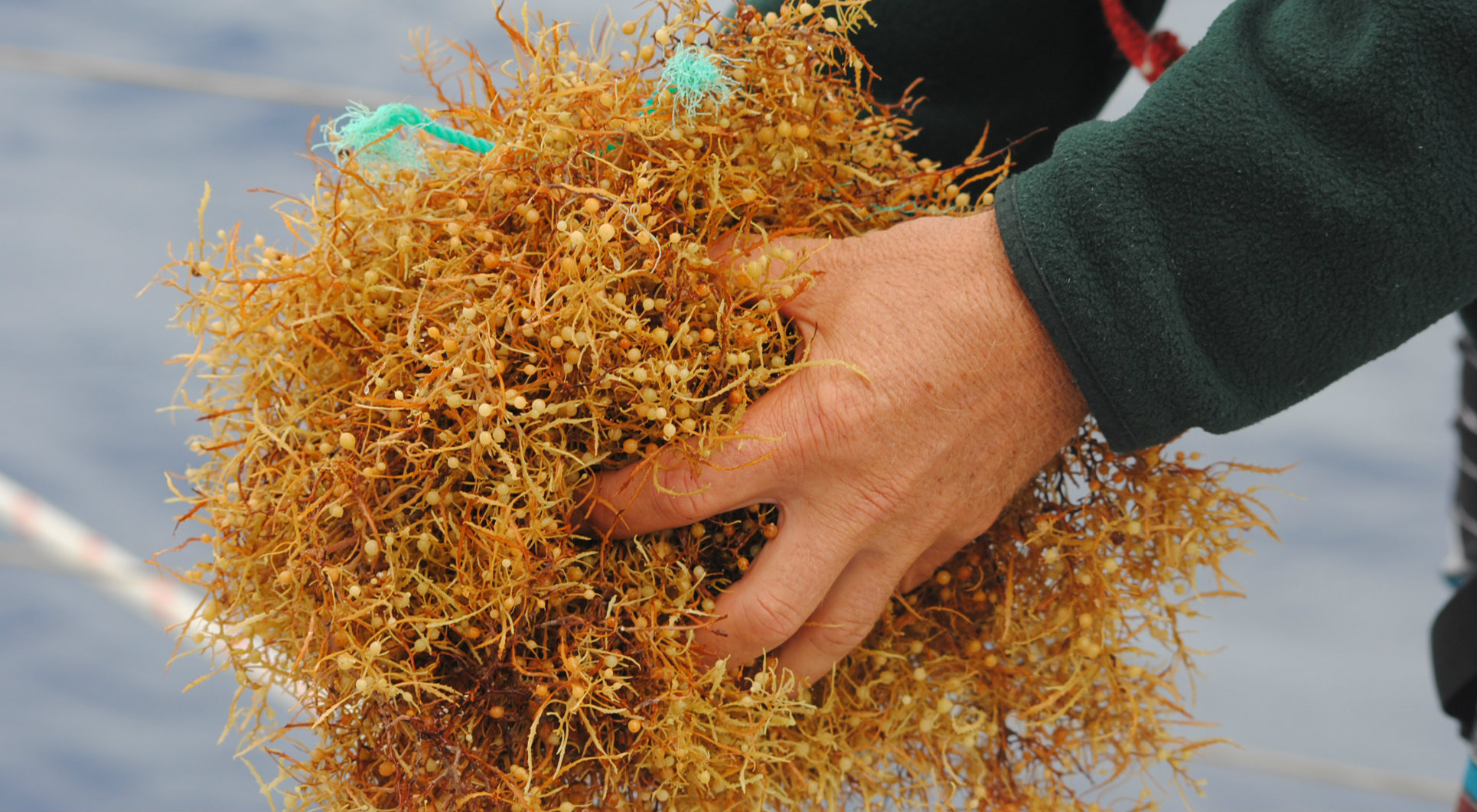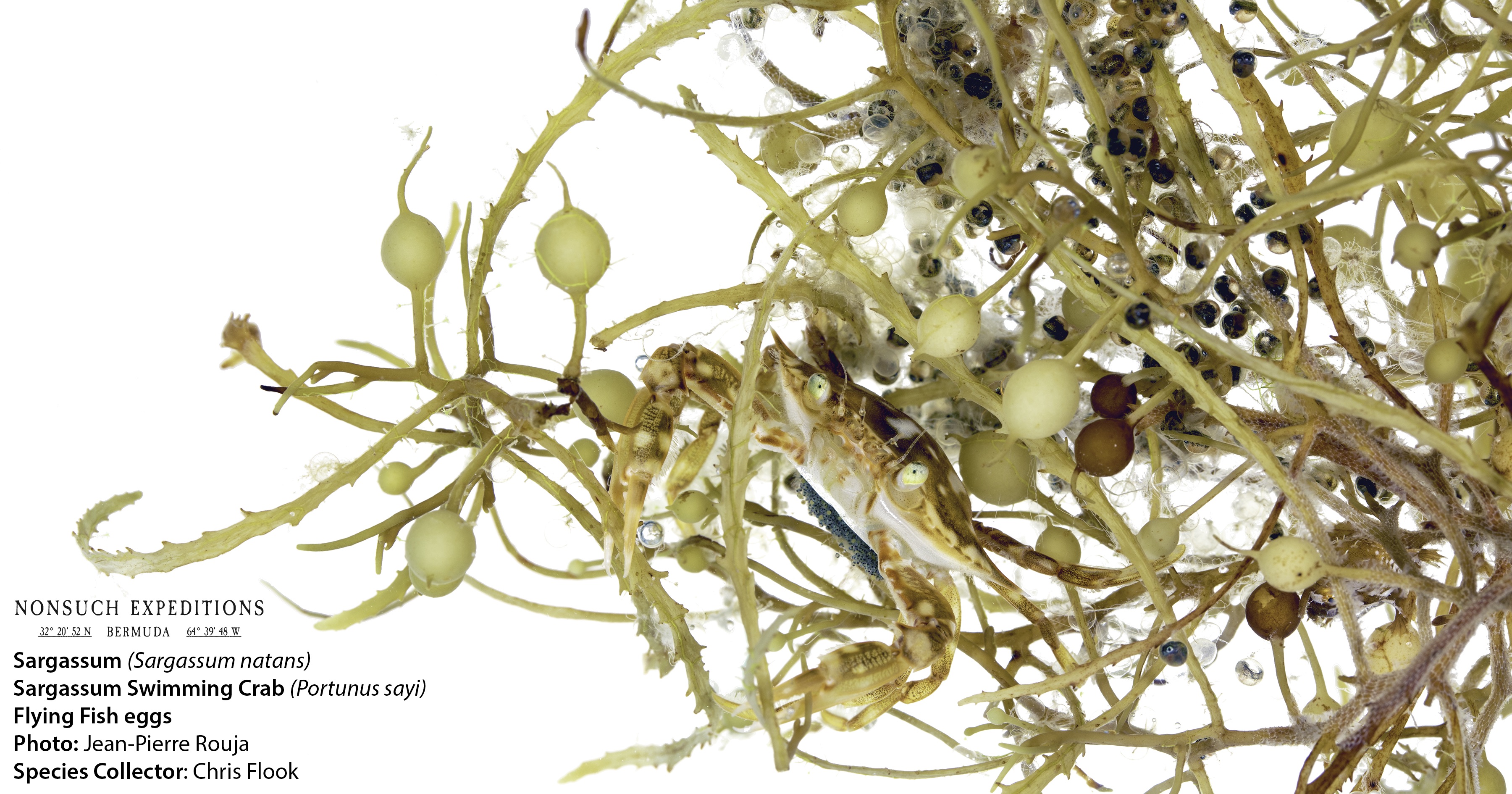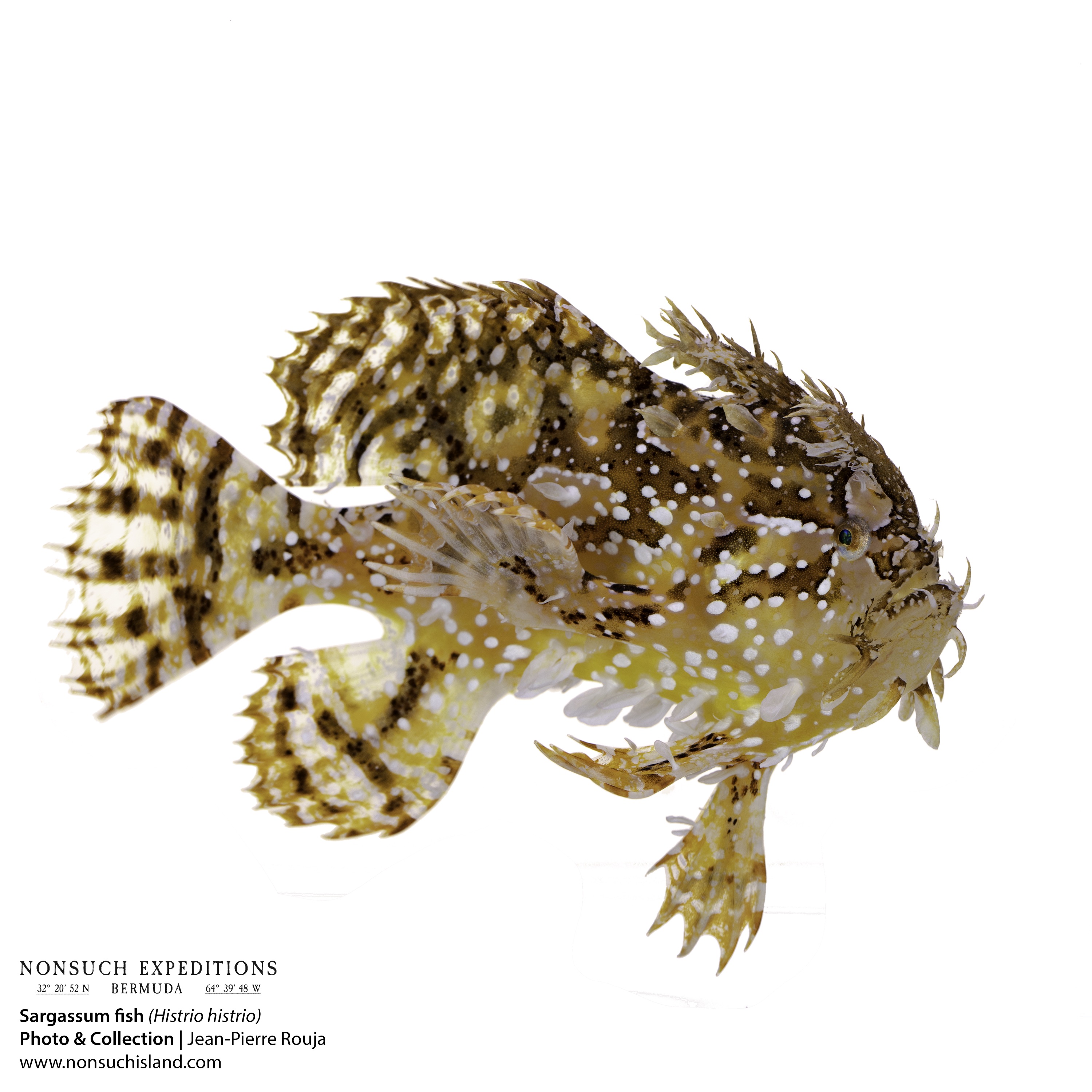Ecological Value
"The Sargasso Sea is...a place of great beauty and ecological value, a golden floating forest in the surface waters of the North Atlantic – an oasis of marine life and the only sea without shores—containing species that are endemic to Sargassum and many others that are specially adapted for life amongst the floating canopy."
"The Sargasso Sea is a refuge of life in the open ocean with a characteristic surface ecosystem based upon Sargassum, which hosts its own unique communities, while acting as a nursery and feeding area for many species, and a migration route for others. It is a vital habitat for many species of economic importance to Bermuda and countries on both sides of the Atlantic—the Sargasso Sea is truly a cross-roads of the Atlantic Ocean.
 Photo credit: JP Rouja, Look BermudaThe surface ecosystem is based upon two species of floating Sargassum both of which reproduce solely by fragmentation and are thus holopelagic and distinct from all other seaweeds (Deacon 1942, Stoner 1983). Floating Sargassum evolved over 40 million years ago from benthic species (Butler et al 1983, Stoner and Greening 1984, South Atlantic Fishery Management Council 2002). Both species are golden brown in colour and float due to small gas-filled bladders (Figure 4); S. natans has a delicate fine leaf structure, whereas S.fluitans has large lanceolate leaves. Together they form clumps or large floating mats that often aggregate into characteristic regularly spaced lines or ‘windrows’ that stretch for considerable distances parallel to the wind. These mats have been likened to a golden floating rain forest filled with life.
Photo credit: JP Rouja, Look BermudaThe surface ecosystem is based upon two species of floating Sargassum both of which reproduce solely by fragmentation and are thus holopelagic and distinct from all other seaweeds (Deacon 1942, Stoner 1983). Floating Sargassum evolved over 40 million years ago from benthic species (Butler et al 1983, Stoner and Greening 1984, South Atlantic Fishery Management Council 2002). Both species are golden brown in colour and float due to small gas-filled bladders (Figure 4); S. natans has a delicate fine leaf structure, whereas S.fluitans has large lanceolate leaves. Together they form clumps or large floating mats that often aggregate into characteristic regularly spaced lines or ‘windrows’ that stretch for considerable distances parallel to the wind. These mats have been likened to a golden floating rain forest filled with life.
The Sargasso Sea is the only area of significant Sargassum distribution where it grows in truly open ocean, thereby providing a rare form of valuable habitat in deep open water far from land. Recently the MERIS satellite has been used to track the movements of Sargassum and to estimate a biomass of around one million tonnes in the Sargasso Sea (Gower and King 2008, Gower and King 2011). ...
Together with its persistence, it is the great area and thickness of the floating Sargassum, which in turn attracts a great density and diversity of associated organisms, that distinguishes this floating ecosystem from that of any other drift algae (Coston-Clements, Settle, Hoss, and Cross 1991, Moser, Auster and Bichy 1998, Casazza and Ross 2008). Other drift algae habitats exist (e.g. Kingsford and Coat 1985, Kingsford 1995, Salovius, Nyqvist and Bonsdorff 2005) but these generally occur in coastal waters and are short-lived. As the Sargassum drifts round it collects “passengers” which increases the diversity of attached invertebrates that settle upon it; this biodiversity varies seasonally, as well as with location in the gyre, and the age of the algae (Stoner and Greening 1984).

Given the long evolutionary history of Sargassum in the Sargasso Sea it is not surprising that many species have become specially adapted for life in this floating forest (Hemphill 2005). Ten species are known to be endemic to floating Sargassum—the Sargassum crab (Planes minutes), Sargassum shrimp (Latreutes fucorum), Sargassum pipefish (Syngnathus pelagicus), Sargassum anemone (Anemonia sargassensis), the Sargassum slug (Scyllea pelagica), the Sargassum snail (Litiopa melanostoma), the amphipods Sunampithoe pelagica and Biancolina brassicacephala, and the platyhelminth Hoploplana grubei. Most of the endemics are camouflaged in some way and perhaps the most iconic is the Sargassum Angler Fish (Histrio histrio) ..., which has both camouflage and modified fins which it uses to creep around the weed (Coston-Clements et al. 1991, South Atlantic Fishery Management Council 2002, Trott, McKenna,Pitt, Hemphill, Ming, Rouja, Gjerde, Causey, and Earle 2011).
 In addition to the endemics the Sargassum is home to a rich community of small invertebrates and fishes. More than 145 invertebrate species have been recorded in association with Sargassum, including a variety of gastropod and nudibranch molluscs, portunid and amphipod crustaceans, pycnogonids, serpulid and nereid polychaetes, flatworms, bryozoans and hydroids (Fine 1970, Morris and Mogelberg 1973, Butler et al. 1983, Coston-Clements et al. 1991, Sterrer 1992, Calder 1995, South Atlantic Fishery Management Council 2002, Trott et al 2011).
In addition to the endemics the Sargassum is home to a rich community of small invertebrates and fishes. More than 145 invertebrate species have been recorded in association with Sargassum, including a variety of gastropod and nudibranch molluscs, portunid and amphipod crustaceans, pycnogonids, serpulid and nereid polychaetes, flatworms, bryozoans and hydroids (Fine 1970, Morris and Mogelberg 1973, Butler et al. 1983, Coston-Clements et al. 1991, Sterrer 1992, Calder 1995, South Atlantic Fishery Management Council 2002, Trott et al 2011).
Sargassum also provides a habitat for over 127 species of fish and, although some of these species may be limited to coastal areas, at least 80 species have been recorded offshore (Dooley 1972, Fedoryako 1980, Coston-Clements et al. 1991, South Atlantic Fishery Management Council 2002, Casazza and Ross 2008, Sutton, Wiebe, Madin and Bucklin 2010). The Sargassum weed provides a habitat and for some invertebrates and juvenile fish a food source (Rooker, Turner and Holt 2006), and the fauna living within the Sargassum reciprocates by providing essential nutrients to the weed (Lapointe 1995), thereby maintaining a balance within the community. This diverse community of organisms living at the surface also interacts with the typical oceanic fauna of fishes and invertebrates that are similar to those found worldwide at these latitudes, many of which migrate vertically up at night and down during the day, thus providing connectivity between the surface community and the deep-sea....
The overall importance of Sargassum for fish has been recognised by the USA which, following the Fishery Management Plan set out in 2002 (South Atlantic Fishery Management Council 2002), has designated Sargassum as essential fish habitat (National Marine Fisheries Service 2003). ICCAT has also recognised the importance of Sargassum as fish habitat and has requested that Contracting Parties assess the ecological status of Sargassum as habitat for tuna, billfish and sharks. It has also asked countries to report on activities that may affect the abundance of Sargassum (ICCAT 2005, ICCAT 2011a). This is one of the first actions by ICCAT to address fish habitat."
Above is an excerpted text (pages 12-13). When referenced this report should be referred to as:
Laffoley, D.d’A., Roe, H.S.J., Angel, M.V., Ardron, J., Bates, N.R, Boyd, I.L., Brooke, S., Buck, K.N., Carlson, C.A., Causey, B., Conte, M.H., Christiansen, S., Cleary, J., Donnelly, J., Earle, S.A., Edwards, R., Gjerde, K.M., Giovannoni, S.J., Gulick, S., Gollock, M., Hallett, J., Halpin, P., Hanel, R., Hemphill, A., Johnson, R.J., Knap, A.H., Lomas, M.W., McKenna, S.A., Miller, M.J., Miller, P.I., Ming, F.W., Moffitt, R., Nelson, N.B., Parson, L., Peters, A.J., Pitt, J., Rouja, P., Roberts, J., Roberts, J., Seigel, D.A., Siuda, A.N.S., Steinberg, D.K., Stevenson, A., Sumaila, V.R., Swartz, W., Thorrold, S., Trott, T.M., and V. Vats. 2011. The protection and management of the Sargasso Sea: The golden floating rainforest of the Atlantic Ocean. Summary Science and Supporting Evidence Case.Sargasso Sea Alliance, 44 pp. Click here to download full report PDF which includes figures mentioned above.


